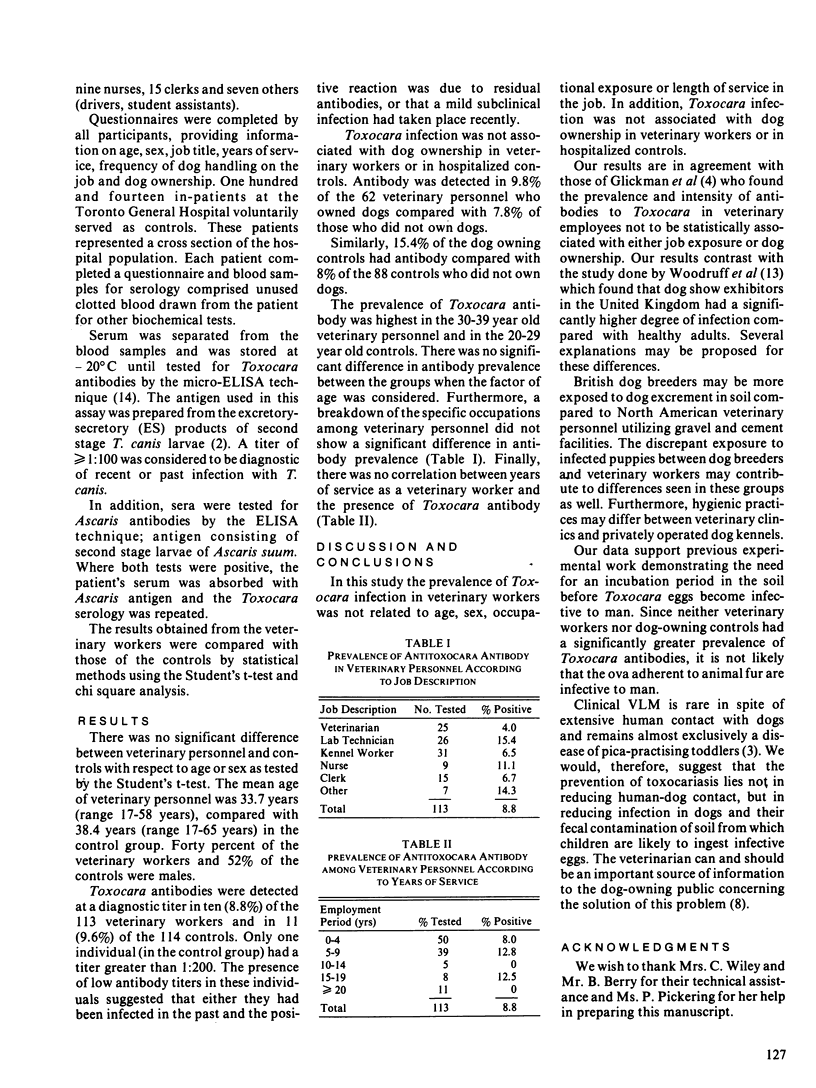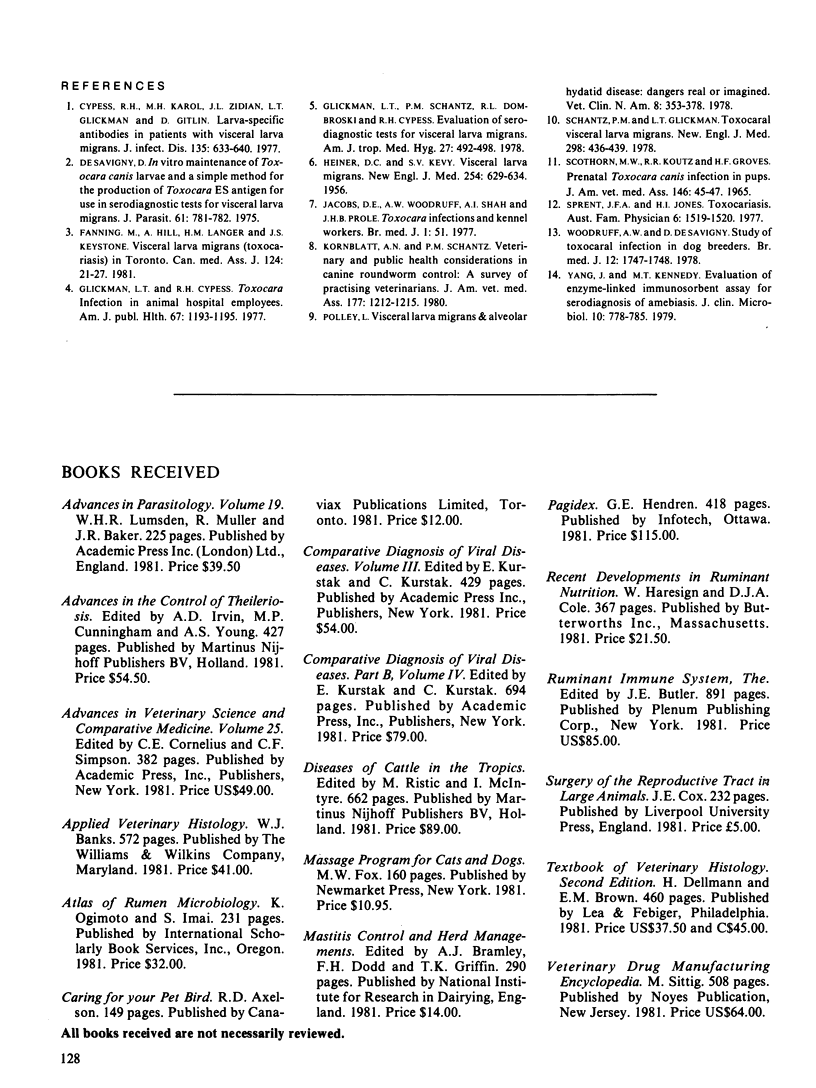Abstract
The prevelance of antibodies to Toxocara canis was determined in 113 veterinary personnel from 22 animal clinics. One hundred and fourteen adult hospital in-patients served as controls. All participants completed a questionnaire supplying personal data and specifies regarding animal exposure and dog ownership. Antibodies to Toxocara were detected by enzyme linked immunosorbent assay (ELISA) employing as antigen, excretorysecretory products from second stage larvae of Toxocara canis.
Toxocara antibodies were found in ten (8.8%) of 113 veterinary workers and in 11 (9.6%) of 114 controls. Antibody prevalence was no different between males and females. Toxocara infection was not associated with dog ownership in veterinary workers or in hospitalized controls. A breakdown of the specific occupations among veterinary personnel failed to show a difference in antibody prevalence, nor did years of service as a veterinary worker correlate with the presence of Toxocara antibody.
Our results suggest that toxocariasis is not associated with direct humandog contact nor with occupational exposure to dogs.
Full text
PDF


Selected References
These references are in PubMed. This may not be the complete list of references from this article.
- Cypess R. H., Karol M. H., Zidian J. L., Glickman L. T., Gitlin D. Larva-specific antibodies in patients with visceral larva migrans. J Infect Dis. 1977 Apr;135(4):633–640. doi: 10.1093/infdis/135.4.633. [DOI] [PubMed] [Google Scholar]
- Fanning M., Hill A., Langer H. M., Keystone J. S. Visceral larva migrans (toxocariasis) in Toronto. Can Med Assoc J. 1981 Jan 1;124(1):21–26. [PMC free article] [PubMed] [Google Scholar]
- Glickman L. T., Cypess R. H. Toxocara infection in animal hospital employees. Am J Public Health. 1977 Dec;67(12):1193–1195. doi: 10.2105/ajph.67.12.1193. [DOI] [PMC free article] [PubMed] [Google Scholar]
- Glickman L., Schantz P., Dombroske R., Cypess R. Evaluation of serodiagnostic tests for visceral larva migrans. Am J Trop Med Hyg. 1978 May;27(3):492–498. doi: 10.4269/ajtmh.1978.27.492. [DOI] [PubMed] [Google Scholar]
- HEINER D. C., KEVY S. V. Visceral larva migrans; report of the syndrome in three siblings. N Engl J Med. 1956 Apr 5;254(14):629–636. doi: 10.1056/NEJM195604052541401. [DOI] [PubMed] [Google Scholar]
- Jacobs D. E., Woodruff A. W., Shah A. I., Prole J. H. Toxocara infections and kennel workers. Br Med J. 1977 Jan 1;1(6052):51–51. doi: 10.1136/bmj.1.6052.51. [DOI] [PMC free article] [PubMed] [Google Scholar]
- Kornblatt A. N., Schantz P. M. Veterinary and public health considerations in canine roundworm control: a survey of practicing veterinarians. J Am Vet Med Assoc. 1980 Dec 15;177(12):1212–1215. [PubMed] [Google Scholar]
- Polley L. Visceral larva migrans and alveolar hydatid disease. Dangers real or imagined. Vet Clin North Am. 1978 May;8(2):353–378. doi: 10.1016/s0091-0279(78)50041-5. [DOI] [PubMed] [Google Scholar]
- SCOTHORN M. W., KOUTZ F. R., GROVES H. F. PRENATAL TOXOCARA CANIS INFECTION IN PUPS. J Am Vet Med Assoc. 1965 Jan 1;146:45–48. [PubMed] [Google Scholar]
- Savigny D. H. In vitro maintenance of Toxocara canis larvae and a simple method for the production of Toxocara ES antigen for use in serodiagnostic tests for visceral larva migrans. J Parasitol. 1975 Aug;61(4):781–782. [PubMed] [Google Scholar]
- Schantz P. M., Glickman L. T. Toxocaral visceral larva migrans. N Engl J Med. 1978 Feb 23;298(8):436–439. doi: 10.1056/NEJM197802232980806. [DOI] [PubMed] [Google Scholar]
- Sprent J. F., Jones H. I. Toxocariasis. Aust Fam Physician. 1977 Dec;6(12):1519–1525. [PubMed] [Google Scholar]
- Woodruff A. W., de Savigny D., Jacobs D. E. Study of toxocaral infection in dog breeders. Br Med J. 1978 Dec 23;2(6154):1747–1748. doi: 10.1136/bmj.2.6154.1747-a. [DOI] [PMC free article] [PubMed] [Google Scholar]
- Yang J., Kennedy M. T. Evaluation of enzyme-linked immunosorbent assay for the serodiagnosis of amebiasis. J Clin Microbiol. 1979 Dec;10(6):778–785. doi: 10.1128/jcm.10.6.778-785.1979. [DOI] [PMC free article] [PubMed] [Google Scholar]


